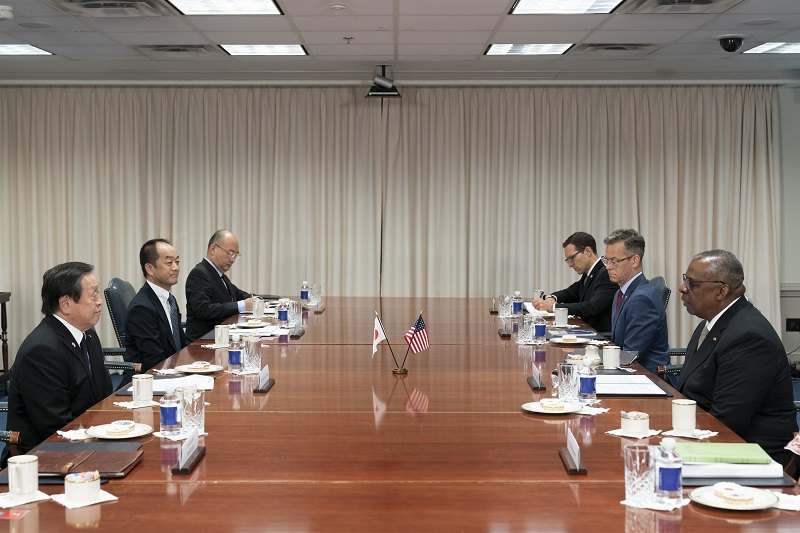Japan gets U.S. support for its stance to mull counterstrike capabilities

Japan’s Defense Minister Yasukazu Hamada, left, meets with U.S. Defense Secretary Lloyd Austin, right, at the Pentagon in Washington on Wednesday.
16:41 JST, September 15, 2022
WASHINGTON — Defense Minister Yasukazu Hamada met with his U.S. counterpart Lloyd Austin in the United States on Wednesday, where he conveyed Japan’s intention to consider possessing “counterstrike capabilities” to destroy enemy missile-launch bases and other targets in self-defense.
Austin expressed his strong support for these efforts. The two ministers held in-person talks for the first time since Hamada took up his current post.
Hamada and Austin agreed to strengthen Japan-U.S. cooperation further, given that the security environment in East Asia has become severe due to China’s increased military pressure on Taiwan and other factors.
During the meeting, Hamada said, “The will and the capability to defend one’s own country are more important than anything else.”
He conveyed Japan’s intention to reinforce its defense capabilities drastically and to work on a “substantial increase” in defense spending, as the Japanese government plans to revise three key security documents, including the National Security Strategy, at the end of this year.
Austin stressed Washington’s “unwavering commitment to the defense of Japan” and referred to U.S. military power, including its nuclear capabilities, providing extended deterrence for U.S. ally Japan. The U.S. defense secretary reaffirmed that Article 5 of the Japan-U.S. Security Treaty, which stipulates U.S. defense obligations to Japan, applies to the Senkaku Islands in Okinawa Prefecture.
The two ministers confirmed that they would deepen discussions at the ministerial level to ensure that the extended deterrence remains credible.
Hamada and Austin also strongly condemned China’s large-scale military exercises near Taiwan, including firings of ballistic missiles that fell within Japan’s exclusive economic zone (EEZ).
“China’s coercive actions in the Taiwan Strait and in the waters surrounding Japan are provocative, destabilizing and unprecedented,” Austin said.
In light of Russia’s invasion of Ukraine as well, the two ministers agreed that Japan and the United States will work closely together without tolerating unilateral changes to the status quo by force.
They agreed that Tokyo and Washington will jointly analyze image and other data collected by the U.S. military’s MQ-9 drones, which are scheduled to be deployed temporarily at the Maritime Self-Defense Force’s Kanoya Air Base in Kagoshima Prefecture from late October. The move is aimed to strengthen the surveillance of China’s growing maritime expansion in the East China Sea and the South China Sea.
Regarding technical cooperation on defense equipment, the two ministers agreed to start considering joint research on technologies and components that could lead to the development of future interceptor missiles in order to counter hypersonic weapons being developed by China and Russia.




